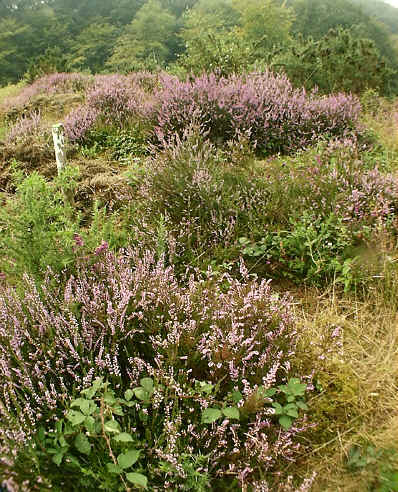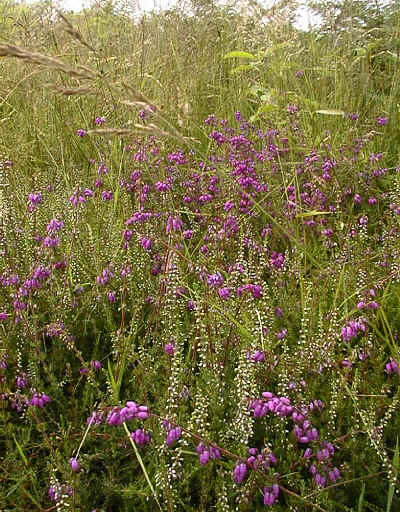|
The Woodland Education Centre |
|
|
The Woodland Education Centre |
|
Ecological Survey 2001
Summary
| SIX YEARS after the beginning
of experimental management.... A total of 92 different plant species were recorded on the project site in 2001, through general observation, as well as surveying with a total of 207 quadrats.
|
| 1. Common Bent
and bramble had become the two most dominant species on the project site. Yorkshire Fog had continued to decline in abundance across much of the project site and had slipped two places in the site dominance table to become only the 4th most dominant species on the site. The chart on the left shows Common Bent abundance in blue and Yorkshire Fog in yellow. (Click on the image to access a larger version of the chart.) The only section in which Yorkshire Fog was the dominant grass was section 4 (spring cut). |
|
. |
|
|
2.
The management regime in section 6 (cutting three times a year) is the only
regime which appeared to be keeping bramble in check on the project site. Bramble has been one of the most dominant species since the start of the experiment. It has established in every single section and occurred with a percentage frequency of 50% or higher in all sections apart from section 6. In section 6 the percentage frequency of occurrence of bramble was only 10% (chart). |
. |
|
 |
3.
Heather had become one of the dominant species over the whole project site. Although its
frequency of occurrence has remained similar throughout the past three years (roughly
22%), its mean % cover has increased slightly. In 2001, the mean % cover recorded for Heather in the samples over the whole project site was 11%. This was actually a higher figure than that recorded for violets (10%). Common Dog-violet is one of the most widely distributed species on the project site. (Violets have a higher % frequency of occurrence than Heather and are therefore ranked higher in the dominance table. They have a higher % frequency because the individual plants are more widely distributed and have a less irregular distribution than Heather.) |
. |
|
 |
4.
Heather (light pink flower
spikes - left) apparently
increased substantially in section 8 this year (chart). However, it was noted last year (2000), that the amount of Heather in
section 8 seemed to have dramatically declined from the previous year. This data was at
odds with visual evidence and it was suggested that this result was a sampling artefact
resulting from the extremely patchy nature of the Heather colonization. This year's results would seem to confirm that assumption, as the amount of Heather recorded had returned to a similar level to 1999. There was perhaps a slight increase in overall mean % cover of Heather in the section over 1999 levels. |
. |
|
|
5.
Autumn cut sections appeared to have more tree seedlings than spring cut
sections. This may simply be a result of the fact that the tree seedlings in autumn cut sections were much larger and more prominent at the time of sampling than the tree seedlings in the spring cut sections. (Tree seedlings in spring cut sections would have been cut to ground level not long before sampling and so would not have had much time to regenerate.) |
. |
|
|
6.
Autumn cutting also seems to be favouring the encroachment of Bracken (left). All three autumn cut sections had developed quite extensive stands of Bracken in the lower halves of the sections. While Bracken was certainly present in spring cut sections, it was not nearly so prominent. |
. |
|
|
7.
The Small Pearl-bordered Fritillary (left), a species which is of conservation concern, was recorded on the project
site for the first time in 2001. This was no accident as the caterpillars of this species feed on violets, including the Common Dog-violet (Viola riviniana), so abundant on the project site (chart). The female butterflies lay their eggs on or near the violets. |
. |
|
|
8.
Six years after the start of experimental management, succession was beginning to take
place in section 9, despite the hand weeding regime. Silver Birch (left) had increased and was the second most dominant species in this section after bramble. Many of the birch saplings were by now up to160cm tall Other tree species which were well established were cherry, willow and Rowan. Many of these were beyond pulling by hand. Much of the older Heather was becoming coarse and rank. Patches of rhododendron were also becoming re-established in isolated places. |
. |
|
|
9.
The control section, which has had no management, was by now
mainly composed of very tall gorse, interspersed with young trees and interlaced with
tangled thickets of brambles. The maximum height of the section had reached 4m in places. Gorse had increased substantially in the control section over the year. It fact, this was the only section where there was a really significant change in gorse abundance. Much of the gorse was becoming very leggy and sparse beneath the main crown of branches. |
Ecological Survey 2001 |